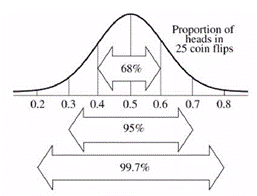
Concept explainers
(a)
To use the rule
(a)
Explanation of Solution
It is given in the question, the professor in the class has each person toss a coin
Thus, about

(b)
To confirm that you can use normal model here.
(b)
Answer to Problem 7E
Yes, the normal model can be used here.
Explanation of Solution
It is given in the question, the professor in the class has each person toss a coin
(c)
To check the appropriate condition to justify your model.
(c)
Explanation of Solution
It is given in the question, the professor in the class has each person toss a coin
Thus, now we know that about

(d)
To explain how the sampling distribution model changes as the number of tosses increases.
(d)
Answer to Problem 7E
As the number of tosses increases, sampling distribution will be less spread out.
Explanation of Solution
It is given in the question, the professor in the class has each person toss a coin
Chapter 18 Solutions
Stats: Modeling the World Nasta Edition Grades 9-12
Additional Math Textbook Solutions
Fundamentals of Statistics (5th Edition)
Basic Business Statistics, Student Value Edition
Statistical Reasoning for Everyday Life (5th Edition)
Elementary Statistics Using Excel (6th Edition)
Introductory Statistics (2nd Edition)
 MATLAB: An Introduction with ApplicationsStatisticsISBN:9781119256830Author:Amos GilatPublisher:John Wiley & Sons Inc
MATLAB: An Introduction with ApplicationsStatisticsISBN:9781119256830Author:Amos GilatPublisher:John Wiley & Sons Inc Probability and Statistics for Engineering and th...StatisticsISBN:9781305251809Author:Jay L. DevorePublisher:Cengage Learning
Probability and Statistics for Engineering and th...StatisticsISBN:9781305251809Author:Jay L. DevorePublisher:Cengage Learning Statistics for The Behavioral Sciences (MindTap C...StatisticsISBN:9781305504912Author:Frederick J Gravetter, Larry B. WallnauPublisher:Cengage Learning
Statistics for The Behavioral Sciences (MindTap C...StatisticsISBN:9781305504912Author:Frederick J Gravetter, Larry B. WallnauPublisher:Cengage Learning Elementary Statistics: Picturing the World (7th E...StatisticsISBN:9780134683416Author:Ron Larson, Betsy FarberPublisher:PEARSON
Elementary Statistics: Picturing the World (7th E...StatisticsISBN:9780134683416Author:Ron Larson, Betsy FarberPublisher:PEARSON The Basic Practice of StatisticsStatisticsISBN:9781319042578Author:David S. Moore, William I. Notz, Michael A. FlignerPublisher:W. H. Freeman
The Basic Practice of StatisticsStatisticsISBN:9781319042578Author:David S. Moore, William I. Notz, Michael A. FlignerPublisher:W. H. Freeman Introduction to the Practice of StatisticsStatisticsISBN:9781319013387Author:David S. Moore, George P. McCabe, Bruce A. CraigPublisher:W. H. Freeman
Introduction to the Practice of StatisticsStatisticsISBN:9781319013387Author:David S. Moore, George P. McCabe, Bruce A. CraigPublisher:W. H. Freeman





